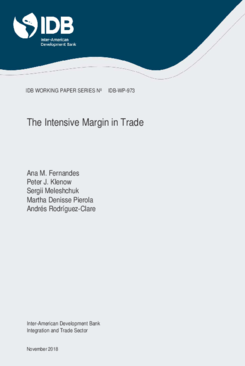The Intensive Margin in Trade
Date
Nov 2018
The Melitz model highlights the importance of the extensive margin (the number of firms exporting) for trade flows. Using the World Bank’s Exporter Dynamics Database (EDD) featuring firm-level exports from 50 countries, we find that around 50% of variation in exports is along the extensive margin — a quantitative victory for the Melitz framework. The remaining 50% on the intensive margin (exports per exporting firm) contradicts a special case of Melitz with Pareto-distributed firm productivity, which has become a tractable benchmark. This benchmark model predicts that, conditional on the fixed costs of exporting, all variation in exports across trading partners should occur on the extensive margin. We find that moving from a Pareto to a lognormal distribution allows the Melitz model to match the role of the intensive margin in the EDD. We use likelihood methods and the EDD to estimate a generalized Melitz model with a joint lognormal distribution for firm-level productivity, fixed costs and demand shifters, and use “exact hat algebra” to quantify the effects of a decline in trade costs on trade flows and welfare in the estimated model. The welfare effects turn out to be quite close to those in the standard Melitz-Pareto model when we choose the Pareto shape parameter to fit the average trade elasticity implied by our estimated Melitz-lognormal model, although there are significant differences regarding the effects on trade flows.



